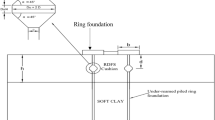Abstract
Previous plane strain analysis of a case history has shown that cross walls in an excavation can effectively reduce movements induced by deep excavation. This study performed three-dimensional numerical analyses for 4 deep excavation cases with different installations of cross walls, including different excavation depths, cross wall intervals and cross wall depths. Both the observed and computed wall deflections for the 4 cases were compared with those of the same excavations that were assumed with no cross walls installed to demonstrate the effectiveness of cross walls in reducing lateral wall deflections. The results show that the cross wall also had a corner effect similar to that of the diaphragm wall. The deflection of the diaphragm wall was smallest at the location of the cross wall installed and then increased with the increasing distance from the cross wall, up to the midpoint between two cross walls. Many factors such as in situ soil properties, diaphragm wall properties, construction procedure, cross wall depth and so on may affect the amount of reduction in lateral wall deflections due to the installation of cross walls. Under the same condition, the amount of reduction was highly dependent on the depth of cross walls, distance to the cross walls and the cross wall interval.

















Similar content being viewed by others
References
Alpan I (1967) The empirical evaluation of the coefficient K 0 and K 0R . Soils Found VII:31–40
Duncan JM, Byune P, Wong KS, Mabry P (1980) Strength, stress-strain and bulk modulus parameters for finite element analysis of stresses and movements in soil masses. Report No.UCB/GT/80-01, Department of Civil Engineering, University of California, Berkeley
Huang CT, Lin YK, Kao TC, Moh ZC (1987) Geotechnical engineering mapping of the Taipei city. Proceedings of the 9th Southeast Asian Geotechnical Conference, Bangkok, Thailand. Vol. 1, pp. 3–109 to 3–120
Itasca Consulting Group, Inc. (1997) FLAC3D: fast lagrangian analysis of continua Ver. 2.1, Minnesota, USA
Jaky J (1944) The coefficient of earth pressure at rest. J Soc Hungarian Archit Eng 78:355–358
Janbu N (1963) Soil compressibility as determined by oedometer and triaxial tests. European conference on soil mechanics and foundation engineering, Wiesbaden, Germany, 1:19–25
Kung TC, Ou CY, Juang CH (2009) Modeling small-strain behavior of Taipei clays for finite element analysis of braced excavations. Comput Geotech 36:304–319
Ladd CC, Foott R, Ishihara K, Schlosser F, Poulos HG (1977) Stress-deformation and strength characteristics. Proceedings of 9th international conference on soil mechanics and foundation engineering, Tokyo, Japan 2:421–494
Lambrughi A, Rodriguez LM, Castellanza R (2012) Development and validation of a 3D numerical model for TBM–EPB mechanised excavations. Comput Geotech 40:97–113
Lim A, Ou CY, Hsieh PG (2010) Evaluation of clay constitutive models for analysis of deep excavation under undrained conditions. J GeoEng 5:9–20
Lin YL (2010) The effects of cross walls on the movements of excavations in clay. National Taiwan University of Science and Technology, Dissertation
Ou CY(2006) Deep excavation-theory and practice. Taylor and Francis
Ou CY, Lai CH (1994) Finite-element analysis of deep excavation in layered sandy and clayey soil deposits. Can Geotech J 31:204–214
Ou CY, Hsieh PG, Chiou DC (1993) Characteristics of ground surface settlement during excavation. Can Geotech J 30:758–767
Ou CY, Chiou DC, Wu TS (1996) Three dimensional finite element analysis of deep excavation. J Geotech Eng ASCE 122:337–345
Ou CY, Lin YL, Hsieh PG (2006) Case record of an excavation with cross walls and buttress walls. J GeoEng 1:79–86
Ou CY, Hsieh PG, Lin YL (2011) Performance of excavations with cross walls. J Geotech Geoenviron Eng 137:94–104
Roscoe KH, Burland JB (1968) On the generalized stress-strain behavior of ‘wet’ clay, in Engineering Plasticity. In: Heyman J, Leckie FA (eds). Cambridge University Press, pp. 535–609
Wong KS, Broms BB (1989) Lateral wall deflections of braced excavations in clay. J Geotech Eng ASCE 115:853–870
Woo SM, Moh ZC (1990) Geotechnical characteristics of soils in Taipei basin. Proceedings of the 10th Southeast Asian geotechnical conference, Special Taiwan Session, Taipei, 2:51–65
Author information
Authors and Affiliations
Corresponding author
Rights and permissions
About this article
Cite this article
Hsieh, PG., Ou, CY. & Lin, YL. Three-dimensional numerical analysis of deep excavations with cross walls. Acta Geotech. 8, 33–48 (2013). https://doi.org/10.1007/s11440-012-0181-8
Received:
Accepted:
Published:
Issue Date:
DOI: https://doi.org/10.1007/s11440-012-0181-8




